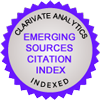Sentetik atıksulardan atık çay sorbentine Cu+2 biyosorpsiyonu: kinetikler, eşitlikler ve termodinamik
Şükrü Aslan1, Sayıter Yıldız2, Mustafa Öztürk31Sivas Cumhuriyet Üniversitesi, Çevre Mühendisliği Bölümü, 58140, Sivas2Cumhuriyet Üniversitesi, Çevre Mühendisliği Bölümü, 58140, Sivas
3Sivas Cumhuriyet Üniversitesi,Organik Tarım Programı, Bitkisel ve Hayvansal Üretim Bölümü, Sivas MYO, Sivas Cumhuriyet Üniversitesi, 58140, Sivas.
Cu2+nin atık çaya (AÇ) biyosorpsiyonu kesikli deneyler ile araştırılmıştır. AÇnin giderme verimi ve biyosorpsiyon kapasitesi (qe), pH, temas süresi, başlangıç Cu+2 derişimi, sıcaklık ve AÇ dozuna göre araştırılmıştır. AÇın qe değeri, çözelti sıcaklığı arttıkça yükselmiştir. Deneysel çalışmalar ile elde edilen R2, qden ve qhes değerlerine göre adsorpsiyon eşitliği en iyi, Langmuir izoterm modeli ile tanımlanmaktadır. AÇye en yüksek Cu+2 biyosorpsiyonu, başlangıç pH ve sıcaklığı olan 6.0 ve 55 0Cde olduğu belirlenmiştir. Deneysel sonuçlar, AÇye, Cu+2 biyosorpsiyonunun endotermik bir reaksiyon olduğunu göstermektedir. Kinetik modeller karşılaştırıldığında biyosorpsiyon en iyi yalancı II. derece kinetik model tarafından tanımlanmaktadır. Negatif ΔG˚ değeri AÇye Cu+2 biyosorpsiyonunun uygulanabilir olduğunu göstermektedir.
Anahtar Kelimeler: Atık çay, biyosorpsiyon, bakır, biyoatık
Biosorption of Cu2+ from synthetic wastewater by tea waste sorbent: kinetics, equilibrium and thermodynamics
Şükrü Aslan1, Sayıter Yıldız2, Mustafa Öztürk31Department of Environmental Engineering, Cumhuriyet University, 58140, Sivas, Turkey2Department of Environmental Engineering, aCumhuriyet University, 58140, Sivas, Turkey
3Department of Organic Agriculture, Sivas Vocational School of Higher Education, Sivas Cumhuriyet University, 58140, Sivas, Turkey
The biosorption of Cu2+ onto the tea wastes (TW) was investigated by performing the batch experiments. The removal efficiency and biosorption capacity (qe) of TW was investigated as a function of pH, contact time, initial Cu2+ concentration, temperature, and TW dose. The qe value of TW increased with the increase of solution temperatures. According to the R2 value, qexp and qcal, the adsorption equilibrium was well described by the Langmuir isotherm model. The highest sorption of Cu2+ onto TW was observed at the initial pH value and temperature of 6.0 and 55°C, respectively. Experimental results confirming that the biosorption reaction of Cu2+ on the TW was thought to be endothermic. By the comparison of kinetic models, results demonstrated that the system was best described by the pseudo second-order kinetic model. The negative ΔG˚ value indicated that the Cu2+sorption onto the TW is feasible.
Keywords: Biosorption, biowaste, copper, waste tea
Makale Dili: Türkçe





